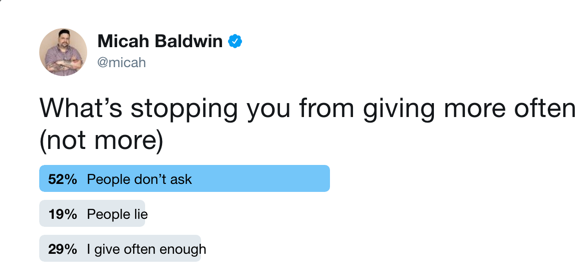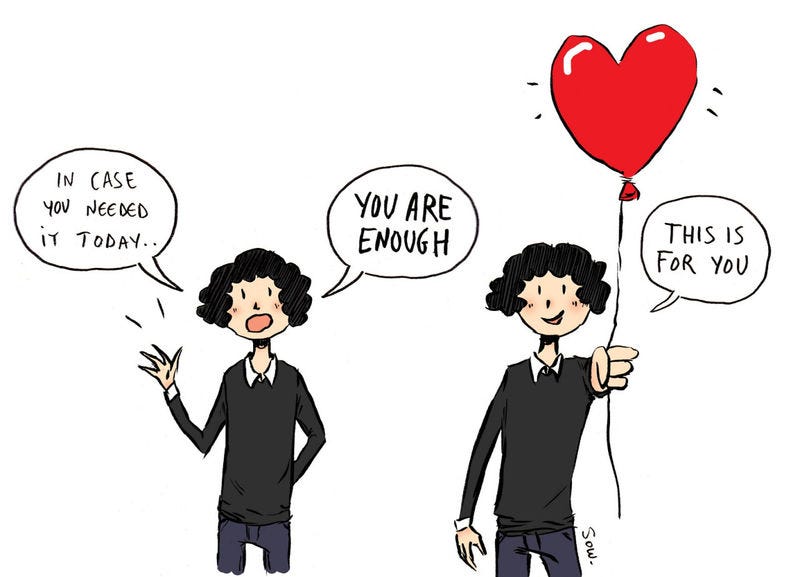Atomic Giving
I woke up this morning with a feeling of trepidation and sense of dread.
Not sure why. Could be that it’s July 4th, and I know once the fireworks go off, my dog Taylor is going to freak out. Badly.
Often when I feel this way, I get lost in my mind.
I lose my grip on the present and spend all my money on memories of the past and contemplations of the future.
It’s a horrible feeling to lose grip on what’s most important, the now.
But this isn’t a woo-woo post.
The other day, I wrote about how Silicon Valley is losing it’s way. Losing it’s core philosophy of collaboration and bidirectional support which is driving out the Givers and replacing them with Takers. The number one question?
How do we fix it? The answer is also how I stop getting lost in my mind.
Every week I get many unsolicited messages on Facebook and Twitter asking for help. I don’t talk about these much, but each one rips my heart out. Each one is asking for something that seems insurmountable. A couple thousand dollars to help feed their family, someone — anyone — to just listen, a connection, or even just validation.
Mixed among the requests for introductions or investment are soul crushing asks. An entrepreneur that has mortgaged their future and now is contemplating suicide. A father just trying to feed his family and too ashamed to ask for help from friends and family. A sick pet, who’s owner has no resources to help heal their only true unconditional love.
I read these all of these, and my heart feels like it’s being squeezed into oblivion from the inside. I cannot help everyone. I want to. So very, very badly. But I can’t. My resources only go so far.
Giving is Viral
About six weeks ago or so, I finally realized that I couldn’t do it alone. I believe strongly that giving is viral, and the problem with giving, is not that there aren’t people willing to give; but that people in need just don’t ask.
I sent a simple tweet:
https://twitter.com/micah/status/865594369822171136
I got requests for about 10. Total time it took to fulfill them all: less than a hour.
The next week I did it again. This time, I was asked for about 15 favors. Including:
https://twitter.com/redheadlefthand/status/868522970314006529
Seriously, amazing. (BTW, I spent time with Michelle. What an amazing person. Check out The Learning House. It take nearly nothing to help it stay open and serve the community. I bet she would love any help.)
Finally, the third week, I asked for others to offer favors. Suddenly, my five favors became 100 (20 people picked up the baton). The next week? 150 favors became available, and it continues to grow.
Intersection of Urgency and Impact
The thing I realized is that giving is atomic. To be effective, one doesn’t have to give big. Recently, Jeff Bezos tweeted:
[embed]https://twitter.com/JeffBezos/status/875418348598603776[/embed]
That tweet, with its 21,000+ responses really smacked me in the heart.
Every response was a link or offer to share some non-profit with Jeff. Mostly because getting the (almost) richest man in the world to participate in your non-profit could be world changing for the organization.
But that’s not what Jeff was asking. (full disclosure: I work at Amazon.) What Jeff was asking was how he could have maximum impact at the moment of need. If someone needed help today, how can one ensure that the support has an outsized positive result?
He wasn’t asking WHAT to give to, but rather HOW to give.
Raising Your Hand
Going back to those Friday Favors (yes, it seems I like to do things on Fridays).
To provide value, size is less important than timing.
Think about all the times when you were in need. What is the commonality?
Urgency.
Given time, there is no obstacle you couldn’t overcome. Resources could be collected over time. A plan developed over time.
Most people, when in need, have no time.
But most people, when in need, don’t self identify, don’t raise their hands, just don’t ask.
Jeff, this is the first problem that needs solving. Creating a safe space so that people, when in need, can be identified.
This is not an easy problem to solve. There has to be the proper balance of anonymity and trust. Many people asked me for favors because of this: Most don’t know me, but trust me based on my collective conversation on Twitter (and here) over, well, time.

a recent Twitter poll
Giving is Atomic
What I learned from the favors experience is that to make a large impact, often the effort is small. One person sent me a note that the favor they did was give a friend a cookie, which led to significant time spent together.
We have a tendency to not give, because we believe to be impactful, we have to give big.
That’s wrong.
We don’t have to give big. We have to give collectively.
Giving is atomic. It’s small. Often, for you it’s a small thing or effort, but to the receiver it’s everything. We assume that because we see it as a small thing, it is actually a small thing.
We are wrong.
Sometimes the needs are large: rent, car payments, medical expenses. But more often than not, they aren’t. In fact, for 50% of middle class American’s would be crushed financially if an unexpected $400 bill popped up.
The Fed asked respondents how they would pay for a $400 emergency. The answer: 47 percent of respondents said that either they would cover the expense by borrowing or selling something, or they would not be able to come up with the $400 at all.
When Billie, my dog, passed almost two years ago, we were getting tests to find out what was wrong with her. Those tests cost $3,500. My rent is $3,500. How many people make decisions based on money versus what’s right? Almost everyone.
51% of insured workers have a deductible of $1000 or more. If $400 is an insurmountable bill, then many insured workers delay ordon’t go to the doctor because they can’t pay the deductible.
Collective Giving and The Bystander Effect
The stories of financial impotence are many. And in each case, the amount of money to avoid disaster is relatively small, even if it is insurmountable for the person in need.
Impact is not driven by a single person. In fact, giving in groups drives a higher level of participation and giving.
“[The Bystander] effect is widely known in groups failing to respond to disasters right in front of their faces, it’s magnified when the disaster is global poverty a continent or two away. We think that because other people around us are not giving, it must also not be our responsibility, and we sure wouldn’t want to be suckered into helping when no one else is doing their fair share.”
The second half of your equation, Jeff? How to have a maximum impact? Engender collective, atomic giving.
This post is much longer than I ever expected it to be. I doubt many will read to this point, but if I am lucky enough that you did, let me give you something small. Something atomic.

http://sow-ay.tumblr.com/image/155800511167
It’s that easy.
